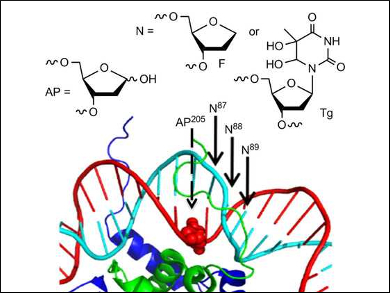Clustered lesions in DNA consist of two or more damaged nucleotides within one or two helical turns. They are a common effect of radiation therapy and are considered to be difficult to repair. An abasic site (AP) is an error frequently found in clustered lesions. Within nucleosome core particles (a segment of DNA packed around eight histone protein cores), the histone proteins catalyze DNA strand scission at such abasic sites. Strand scission within a nucleosome core particle can occur more than 100 times faster than in “naked” DNA.
Marc Greenberg and Kun Yang, Johns Hopkins University, Baltimore, MD, USA, have investigated AP reactivity within a clustered lesion in nucleosome core particles. They observed that the rate of strand breaks in DNA at such an AP is 2.5-fold increased when it is near a thymidine glycol or a chemically stable AP analog (tetrahydrofuran) in the opposite DNA strand. The AP reactivity is also enhanced near mispaired bases.
The correlation of AP reactivity and melting temperature suggests that enhanced AP reactivity within clustered lesions is due to a decreased stability of the DNA double strand. The lesions increase the DNA flexibility and make it easier for the histone proteins to access the AP. Thus, double-strand lesions containing an AP are more prone to strand scission than previously thought.
- Enhanced Cleavage at Abasic Sites within Clustered Lesions in Nucleosome Core Particles,
Kun Yang, Marc M. Greenberg,
ChemBioChem 2018.
https://doi.org/10.1002/cbic.201800338




